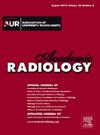A Fusion Model of MRI Deep Transfer Learning and Radiomics for Discriminating between Pilocytic Astrocytoma and Adamantinomatous Craniopharyngioma
IF 3.8
2区 医学
Q1 RADIOLOGY, NUCLEAR MEDICINE & MEDICAL IMAGING
引用次数: 0
Abstract
Rationale and Objectives
This study aimed to develop and validate a fusion model combining MRI deep transfer learning (DTL) and radiomics for discriminating between pilocytic astrocytoma (PA) and adamantinomatous craniopharyngioma (ACP) in the sellar region.
Methods
This study included 348 patients with histologically confirmed PA (n = 139) and ACP (n = 209). Data were randomly divided into training and testing cohorts in a 7:3 ratio. Pre-trained ResNet50 network was utilized to extract DTL features from T1WI, T2WI, and CET1, while radiomics features (Rad) were extracted from manually delineated images of the same modalities. The fusion feature set (DLR) was constructed by integrating these features. Semantic features were used to develop clinical models. Pearson rank correlation and The least absolute shrinkage and selection operator regression were used for feature selection, and K-nearest neighbor algorithm was applied to establish the model. The performance of the model was evaluated using receiver operating characteristic curve. DeLong's test was performed to assess differences between models, and decision curve analysis was conducted to evaluate the clinical utility of the models.
Results
The DLR model achieved AUC values of 0.945 (95% CI, 0.9149–0.9760) in the training cohort and 0.929 (95% CI, 0.8824–0.9762) in the testing cohort, significantly higher than those of models using DTL features, Rad features, or clinical features alone.
Conclusion
The fusion model based on MRI deep transfer learning and radiomics (DLR) demonstrated high accuracy and clinical utility in discriminating between PA and ACP, providing an effective tool for the non-invasive diagnosis of these two diseases.
核磁共振深度转移学习与放射组学的融合模型用于区分嗜碱性星形细胞瘤和金刚瘤性颅咽管瘤
基础和目的:本研究旨在建立并验证MRI深度转移学习(DTL)和放射组学相结合的融合模型,用于鉴别鞍区毛细胞星形细胞瘤(PA)和金刚瘤性颅咽管瘤(ACP)。方法:本研究纳入348例组织学证实的PA (n = 139)和ACP (n = 209)。数据按7:3的比例随机分为训练组和测试组。使用预训练的ResNet50网络从T1WI、T2WI和CET1中提取DTL特征,而从相同模式的手动描绘图像中提取放射组学特征(Rad)。通过对这些特征进行综合,构建融合特征集(DLR)。利用语义特征建立临床模型。采用Pearson秩相关、最小绝对收缩和选择算子回归进行特征选择,采用k近邻算法建立模型。利用接收机工作特性曲线对模型的性能进行了评价。采用DeLong检验评价模型间的差异,采用决策曲线分析评价模型的临床应用价值。结果:DLR模型在训练组的AUC值为0.945 (95% CI, 0.9149 ~ 0.9760),在检验组的AUC值为0.929 (95% CI, 0.8824 ~ 0.9762),均显著高于单独使用DTL特征、Rad特征或临床特征的模型。结论:基于MRI深度迁移学习和放射组学(DLR)的融合模型在鉴别PA和ACP方面具有较高的准确性和临床实用性,为两种疾病的无创诊断提供了有效的工具。
本文章由计算机程序翻译,如有差异,请以英文原文为准。
求助全文
约1分钟内获得全文
求助全文
来源期刊

Academic Radiology
医学-核医学
CiteScore
7.60
自引率
10.40%
发文量
432
审稿时长
18 days
期刊介绍:
Academic Radiology publishes original reports of clinical and laboratory investigations in diagnostic imaging, the diagnostic use of radioactive isotopes, computed tomography, positron emission tomography, magnetic resonance imaging, ultrasound, digital subtraction angiography, image-guided interventions and related techniques. It also includes brief technical reports describing original observations, techniques, and instrumental developments; state-of-the-art reports on clinical issues, new technology and other topics of current medical importance; meta-analyses; scientific studies and opinions on radiologic education; and letters to the Editor.
 求助内容:
求助内容: 应助结果提醒方式:
应助结果提醒方式:


